I have a heavily right-skewed histogram and would like to calculate the probabilities for a range of Lifetimevalues (Area under the curve, the PDF). For instance, the probability that the Lifetime value is in (0-0.01)
Dataframe consisting of LTV calculated by cumulative revenue/ cumulative installs:
df['LTV'] is
(0,0,0,0,0,0,0,0,0,0,0,0,0,0,0,0,0.208125,0.0558879,0.608348,0.212553,0.0865896,
0.728542,0,0.609512,0,0,0,0,0,0,0,0.0801339,0.140657,0.0194118,0,0,0.0634682,
0.339545,0.875902,0.8325,0.0260526,0.0711905,0.169894,0.202969,0.0761538,0,0.342055,
0.42781,0,0,0.192115,0,0,0,0,0,0,0,0,0,0,0,1.6473,0,0.232329,0,2.21329,0.748,0.0424286,
0.455439,0.210282,5.56453,0.427959,0,0.352059,0,0,0.567059,0,0,0,0.384462,1.29476,
0.0103125,0,0.0126923,1.03356,0,0,0.289785,0,0)
I have tried utilizing SKlearn's KernelDensity, however, after fitting it to the histogram it does not capture the over-represented 0s.
import gc
from sklearn.neighbors import KernelDensity
def plot_prob_density(df_lunch, field, x_start, x_end):
plt.figure(figsize = (10, 7))
unit = 0
x = np.linspace(df_lunch.min() - unit, df_lunch.max() + unit, 1000)[:, np.newaxis]
# Plot the data using a normalized histogram
plt.hist(df_lunch, bins=200, density=True, label='LTV', color='blue', alpha=0.2)
# Do kernel density estimation
kd_lunch = KernelDensity(kernel='gaussian', bandwidth=0.00187).fit(df_lunch) #0.00187
# Plot the estimated densty
kd_vals_lunch = np.exp(kd_lunch.score_samples(x))
plt.plot(x, kd_vals_lunch, color='orange')
plt.axvline(x=x_start,color='red',linestyle='dashed')
plt.axvline(x=x_end,color='red',linestyle='dashed')
# Show the plots
plt.xlabel(field, fontsize=15)
plt.ylabel('Probability Density', fontsize=15)
plt.legend(fontsize=15)
plt.show()
gc.collect()
return kd_lunch
kd_lunch = plot_prob_density(final_df['LTV'].values.reshape(-1,1), 'LTV', x_start=0, x_end=0.01)
Then finding the probabilities like this:
def get_probability(start_value, end_value, eval_points, kd):
# Number of evaluation points
N = eval_points
step = (end_value - start_value) / (N - 1) # Step size
x = np.linspace(start_value, end_value, N)[:, np.newaxis] # Generate values in the range
kd_vals = np.exp(kd.score_samples(x)) # Get PDF values for each x
probability = np.sum(kd_vals * step) # Approximate the integral of the PDF
return probability.round(4)
print('Probability of LTV 0-3 tips during LUNCH time: {}\n'
.format(get_probability(start_value = 0,
end_value = 0.01,
eval_points = 100,
kd = kd_lunch)))
However, this method does not yield the appropriate PDF values we were aiming for. Any suggestions for alternative methods would be appreciated.
PLot:
